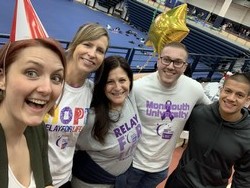J.Crew made a bold statement at this years New York Fashion Week as their models stole the spotlight from the clothing everyone was there to see. This New York brand decided to ditch the pro-fessional models and use the everyday woman, man and child to present its new line to the public. Staffers, friends and family members of J.Crew were featured on the runway to model the clothing in an attempt to create an effortless, relatable and relaxed feel for J.Crew as a fashion company.
A diverse group of non-professional models were seen walking up and down the runway in J.Crew’s latest apparel. The everyday models were a diverse group of people with different skin tones, body shapes and sizes. This “normal people” notion created a brand so relat-able that people watching were able to picture themselves in the clothes, as there wasn’t one standard of unrealistic beauty. Jennifer Shamrock, a Lecturer in the Communication department, comments on the use of real models during this runway: “This is really a move in the right direc-tion for our society. It’s great to hear that the fashion industry is becoming more inclusive and appreciative of different body types in their runways. I think as a society we need to move away from one unrealistic body standard and this is really where it’s going to begin.”
By using everyday people to model their clothes, J.Crew empowered their audience to embrace their uniqueness and helped bridge the gap between the runway and the checkout line. J.Crew sent New York Fashion Week viewers a powerful message that we shouldn’t conform to one stand-ard of beauty and everyone should be celebrated. Stephanie Merlis, a senior business student, re-marks “I think it’s great that J.Crew didn’t use professional models in their run-way during Fashion Week. It helps create a more personable brand and typical beauty stand-ards.”
Although there are many benefits to having real people model clothes on the runway, some spec-ulate the drawbacks of non-professionals partaking in this industry. Modeling careers are competitive, workout intensive and some argue that modeling is an art form not defined by walking up and down a runway. Having everyday people model clothing lines who have not devoted their lives to doing so undermines the hard work, training and dedication of those in the industry who are still only dreaming of modeling in New York Fashion week. Models are also usually the same build and share similar char-acteristics. Models are typically six feet tall, skinny with very defined bone structures and jaw lines. Having models that share dress, pant and shoe sizes is an advantage to fashion designers as they can create pieces that do not have to be custom made to hit the runway. Clothing is not one size fits all, and by using professional models, fashion designers eliminate the need to tailor the same outfit to a multitude of body shapes and sizes.
The use of real people in fashion shows extends far beyond the runways of New York Fashion Week. Non-professional, real-life models have been used in beauty campaigns across the nation. Aer-ie, a clothing store for women recently began photographing their line with untouched, real models to empower young women and defy society’s standard of beauty.
 Following in J.Crew’s footsteps on a smaller stage, Monmouth students got involved in JCPenny’s annual back to school fashion show this September. With the fall season approach-ing, JCPenny modeled their new line of children, men and women’s clothing on members of the local community while giving back to two great causes. The fashion show benefited the philan-thropies of two Greek organizations on our campus, Alpha Xi Delta (Autism Speaks) and Sigma Tau Gamma (Special Olympics). Jessica McGovern, a sophomore communication student and sister of Al-pha Xi Delta, had a great experience participating in the celebration of the everyday person. “I was so grateful to have this experience of being a model in this back to school fashion show,” she says. “It was something that was completely out of my comfort zone, but I knew it was for two amazing causes, and it’s something I would do again in a heartbeat.”
Following in J.Crew’s footsteps on a smaller stage, Monmouth students got involved in JCPenny’s annual back to school fashion show this September. With the fall season approach-ing, JCPenny modeled their new line of children, men and women’s clothing on members of the local community while giving back to two great causes. The fashion show benefited the philan-thropies of two Greek organizations on our campus, Alpha Xi Delta (Autism Speaks) and Sigma Tau Gamma (Special Olympics). Jessica McGovern, a sophomore communication student and sister of Al-pha Xi Delta, had a great experience participating in the celebration of the everyday person. “I was so grateful to have this experience of being a model in this back to school fashion show,” she says. “It was something that was completely out of my comfort zone, but I knew it was for two amazing causes, and it’s something I would do again in a heartbeat.”
The JCPenny fashion show featured models of all ages, sizes and ethnicities and it gave them the opportunity to express their individuality, fashion and style on a stage reminiscent of J.Crew’s show.
J.Crew made a lasting statement through their use of everyday people in the high-end, couture runways of New York Fashion Week. This trend of using real people to model clothes relays a strong message to women, men and children across the nation; they do not have to conform to one standard of beauty to be celebrated.
J.Crew made a bold statement at this years New York Fashion Week as their models stole the spotlight from the clothing everyone was there to see. This New York brand decided to ditch the pro-fessional models and use the everyday woman, man and child to present its new line to the public. Staffers, friends and family members of J.Crew were featured on the runway to model the clothing in an attempt to create an effortless, relatable and relaxed feel for J.Crew as a fashion company.
A diverse group of non-professional models were seen walking up and down the runway in J.Crew’s latest apparel. The everyday models were a diverse group of people with different skin tones, body shapes and sizes. This “normal people” notion created a brand so relat-able that people watching were able to picture themselves in the clothes, as there wasn’t one standard of unrealistic beauty. Jennifer Shamrock, a Lecturer in the Communication department, comments on the use of real models during this runway: “This is really a move in the right direc-tion for our society. It’s great to hear that the fashion industry is becoming more inclusive and appreciative of different body types in their runways. I think as a society we need to move away from one unrealistic body standard and this is really where it’s going to begin.”
By using everyday people to model their clothes, J.Crew empowered their audience to embrace their uniqueness and helped bridge the gap between the runway and the checkout line. J.Crew sent New York Fashion Week viewers a powerful message that we shouldn’t conform to one stand-ard of beauty and everyone should be celebrated. Stephanie Merlis, a senior business student, re-marks “I think it’s great that J.Crew didn’t use professional models in their run-way during Fashion Week. It helps create a more personable brand and typical beauty stand-ards.”
Although there are many benefits to having real people model clothes on the runway, some spec-ulate the drawbacks of non-professionals partaking in this industry. Modeling careers are competitive, workout intensive and some argue that modeling is an art form not defined by walking up and down a runway. Having everyday people model clothing lines who have not devoted their lives to doing so undermines the hard work, training and dedication of those in the industry who are still only dreaming of modeling in New York Fashion week. Models are also usually the same build and share similar char-acteristics. Models are typically six feet tall, skinny with very defined bone structures and jaw lines. Having models that share dress, pant and shoe sizes is an advantage to fashion designers as they can create pieces that do not have to be custom made to hit the runway. Clothing is not one size fits all, and by using professional models, fashion designers eliminate the need to tailor the same outfit to a multitude of body shapes and sizes.
The use of real people in fashion shows extends far beyond the runways of New York Fashion Week. Non-professional, real-life models have been used in beauty campaigns across the nation. Aer-ie, a clothing store for women recently began photographing their line with untouched, real models to empower young women and defy society’s standard of beauty.
Following in J.Crew’s footsteps on a smaller stage, Monmouth students got involved in JCPenny’s annual back to school fashion show this September. With the fall season approach-ing, JCPenny modeled their new line of children, men and women’s clothing on members of the local community while giving back to two great causes. The fashion show benefited the philan-thropies of two Greek organizations on our campus, Alpha Xi Delta (Autism Speaks) and Sigma Tau Gamma (Special Olympics). Jessica McGovern, a sophomore communication student and sister of Al-pha Xi Delta, had a great experience participating in the celebration of the everyday person. “I was so grateful to have this experience of being a model in this back to school fashion show,” she says. “It was something that was completely out of my comfort zone, but I knew it was for two amazing causes, and it’s something I would do again in a heartbeat.”
The JCPenny fashion show featured models of all ages, sizes and ethnicities and it gave them the opportunity to express their individuality, fashion and style on a stage reminiscent of J.Crew’s show.
J.Crew made a lasting statement through their use of everyday people in the high-end, couture runways of New York Fashion Week. This trend of using real people to model clothes relays a strong message to women, men and children across the nation; they do not have to conform to one standard of beauty to be celebrated.
IMAGE TAKEN from Instagram
IMAGE TAKEN from qz.com



